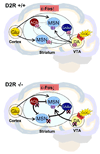Getting specialized: presynaptic and postsynaptic dopamine D2 receptors
- PMID: 19138563
- PMCID: PMC2710814
- DOI: 10.1016/j.coph.2008.12.002
Getting specialized: presynaptic and postsynaptic dopamine D2 receptors
Abstract
Dopamine (DA) signaling controls many physiological functions ranging from locomotion to hormone secretion, and plays a critical role in addiction. DA elevation, for instance in response to drugs of abuse, simultaneously activates neurons expressing different DA receptors; how responses from diverse neurons/receptors are orchestrated in the generation of behavioral and cellular outcomes, is still not completely defined. Signaling from D2 receptors (D2Rs) is a good example to illustrate this complexity. D2Rs have presynaptic and postsynaptic localization and functions, which are shared by two isoforms in vivo. Recent results from knockout mice are clarifying the role of site and D2 isoform-specific effects thereby increasing our understanding of how DA modulates neuronal physiology.
Figures


References
-
- Di Chiara G, Bassareo V. Reward system and addiction: what dopamine does and doesn't do. Curr Opin Pharmacol. 2007;7:69–76. - PubMed
-
- Koob GF. The neurobiology of addiction: a neuroadaptational view relevant for diagnosis. Addiction. 2006;101 Suppl 1:23–30. - PubMed
-
- Tan S, Hermann B, Borrelli E. Dopaminergic mouse mutants: investigating the roles of the different dopamine receptor subtypes and the dopamine transporter. Int Rev Neurobiol. 2003;54:145–197. - PubMed
-
- Baik JH, Picetti R, Saiardi A, Thiriet G, Dierich A, Depaulis A, Le Meur M, Borrelli E. Parkinsonian-like locomotor impairment in mice lacking dopamine D2 receptors. Nature. 1995;377:424–428. - PubMed
Publication types
MeSH terms
Substances
Grants and funding
LinkOut - more resources
Full Text Sources
Other Literature Sources
Molecular Biology Databases

